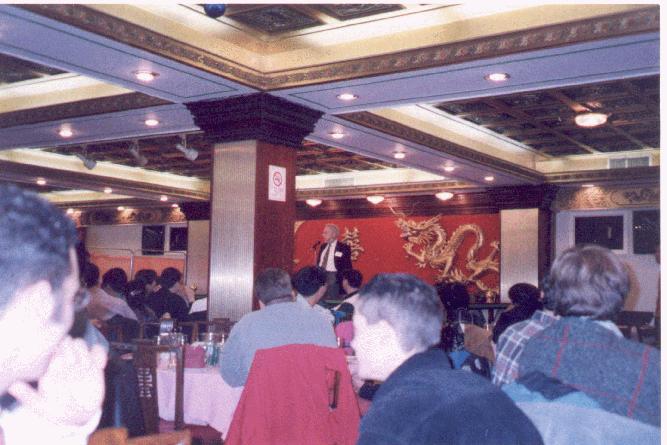
Welcome to the 30th Annual
Inorganic Discussion Weekend
October 24-26, 1997
University of Toronto
Message From the Chair of the Department of Chemistry
Dear Colleague:
It is a privilege and honour for us to host the 30th Inorganic Discussion Weekend this year. As a participant at earlier Weekends years ago I was always impressed with the high quality and vigour of the science presented, the enthusiasm of the participants, and the inspirational effect the program had on students. I hope that besides having a scientifically stimulating time you are able to enjoy the hospitality of the Department of Chemistry, the University of Toronto, and the City.
With all good wishes,
Martin Moskovits
Chair
Department of Chemistry
Overview of the Weekend
Friday, October 24th, 1997
7:00 - 11:00PM Registration, Official Friday Mixer, and Poster Session
Wetmore Hall, New College
Huron Street and Classic Ave.
Toronto
Saturday, October 25th, 1997
8:30 - 10:40AM Registration
Lash Miller Chemistry Building
9:00 Introductory Remarks
Lash Miller Room 159
9:10 - 10:10 Guest Lecture by Professor Maurice Brookhart
Lash Miller Room 159
10:10 - 10:40 Coffee Break
Lash Miller Chemistry Building Lobby
10:40 - 12:00 Oral Presentations
Lash Miller Room 159
12:00 - 2:00 Lunch
2:00 - 4:40 Oral Presentations
Session I: Lash Miller Room 158
Session II: Lash Miller Room 159
There will be a coffee break from 3:10 - 3:30 in the lobby.
4:45 - 7:00 Poster Session
Wetmore Hall, New College
7:30 Banquet
New Pacific Restaurant, Second Floor
421 Dundas Street West
Toronto
Sunday, October 26th, 1997
9:30 - 10:30AM Oral Presentations
Lash Miller Room 158
10:30 - 10:50 Coffee Break
Lash Miller Chemistry Building Lobby
10:50 - 12:40 PM Oral Presentations
Lash Miller Room 158
12:50 Presentation of the Awards
Instructions to Authors
a) Oral Presentations: Overhead and slide projectors (including trays) will be available in the lecture rooms. Please load your carousel before the session or at the coffee break and retrieve your slides after your presentation. Plan your talk for 15 minutes which will be followed by 5 minutes of discussion. On Saturday afternoon, where there are two sessions, 5 minute gaps have been inserted to allow a smooth transition of audience members between the lecture halls.
b) Poster: An area of 119 cm (47") high by 88 cm (35") wide will be provided to you. Please mount your poster on Friday night in Wetmore Hall. At the Friday night registration and mixer, participants may discuss posters. Posters can be left in Wetmore Hall until the second poster session on Saturday evening.
Awards for oral and poster presentations will be presented to graduate students on Sunday at 1:00PM.
SCIENTIFIC PROGRAM
Oral Presentations: Lash Miller Room 159
Saturday, October 25th, 1997
9:00AM Introductory Remarks: Prof. Robert H. Morris
9:10 - 10:10 Plenary Lecture by Professor Maurice Brookhart,
Department of Chemistry, University of North Carolina at Chapel Hill, Chapel Hill, NC, USA.
"Mechanistic and Synthetic Aspects of Olefin Polymerizations Using
Ni(II) and Pd(II) Based Catalysts"
10:10 - 10:40 Coffee Break
Saturday Morning Session
Lash Miller Room
Session Chair: Ian Manners
10:40 - 11:00 EPR Study of the Reactions of the Polymerization Catalysts Cp*TiMe2E (E = Me, Cl, C6F5, OC6F5) with B(C6F5)3 and [Ph3C][B(C6F5)4]
Edan Williams and M. C. Baird
Department of Chemistry, Queen's University, Kingston (Ontario), Canada K7L 3N6.
The half sandwich titanium compounds of the type Cp*TiMe2E (Cp* = pentamethylcyclopentadienyl, E = Me, Cl, C6F5, OC6F5) have previously been shown to be efficient catalysts for the polymerization of a-olefins such as propylene and ethylene when activated with a suitable co-catalyst such as B(C6F5)3 or [PH3C][B(C6F5)4]. As well, under certain conditions, Cp*TiMe3 will polymerize styrene to produce syndiotactic polystyrene. It has been shown that under these conditions, a Ti3+ species is formed and these have been studied by EPR spectroscopy. We have studied the room temperature reactions of the above series of titanium compounds with both co-catalysts via EPR to determine under what conditions and to what extent these Ti3+ species are formed.
11:00 - 11:20 Desulfurization of Dibenzothiophene by a New Dinuclear Nickel Hydride Complex
David A. Vicic and William D. Jones
Department of Chemistry, University of Rochester, Rochester (New York), USA 14627-0216.
The new nickel hydride dimer [(dippe)NiH]2 (1) (dippe = 1,2-bis(di-i-propylphosphino)ethane) was found to react with various thiophenes at room temperature leading to the mono C,S-insertion complexes. The dibenzothiophene (DBT) adduct can further react with (dippe)Ni0 fragments producing novel organometallic compounds in which both of the C-S bonds of DBT have been cleaved. Reaction of the desulfurized species with hydrogen at room temperature leads to the production of biphenyl and the regeneration of 1. Reactivity of 1 with methyl substituted dibenzothiophenes will also be presented.
11:20 - 11:40 The Remarkable Complexity of the Reaction of Lowvalent Niobium with Amides
Maryam Tayebani and Sandro Gambarotta
Department of Chemistry, University of Ottawa, Ottawa (Ontario), Canada K1N 6N5
Reaction of the diamagnetic Nb(II) cluster, (TMEDA)2Nb2Cl5Li(TMEDA), with anionic organic amides forms different compounds depending on the nature of the amide organic substituents. A variety of transformations which have occurred including C-N bond cleavage, as well as formation of nitrides or complexes exhibiting unusual structures with exotic metal oxidation states will be presented and discussed.
11:40 - 12:00 Dehydrogenative Cross-Coupling of Primary Silanes and Phosphines - A reaction Catalyzed by Dimethyltitanocene
Ronghua Shu, Leijun Hao, Hee Gwon Woo, and John F. Harrod
Department of Chemistry, McGill University, Montreal (Quebec), Canada H3A 2K6
Dehydrogenative coupling between silanes and phosphines has been studied using dimethyltitanocene as the precatalyst. Triphosphatrisilacyclohexanes [(-SiHRPR'-)3, R = Ph or CH3Ph; R' = Cy or Ph] were afforded and characterized. The mechanism was proposed and discussed.
12:00 - 2:00 Lunch
Saturday Afternoon Session I
Lash Miller Room 158
Session Chair: Tony Poë
2:00 - 2:20 Singlet-Triplet Crossings in Nickel(II) Compounds, Studied by Polarized Absorption Spectroscopy
Guillaume Bussière and Christian Reber
Département de Chimie, Université de Montréal, Montréal (Québec), Canada H3C 3J7.
Nickel (II) compounds show electronic absorption spectra with unusual vibronic structure. Our goal is to rationalize this using the time-dependent theory of spectroscopy. Forbidden transitions to the singlet excited state (3A2g-> 1Eg, Oh) in all the studied compounds show high intensities and vibrational structure with high spacing. These observations can be explained by intersystem crossing betwen the singlet and a nearby triplet state (3T1g, Oh). The crossing dynamics are governed by the spin orbit coupling constant, l, wich can be obtained independently by RPE spectroscopy.
2:25 - 2:45 Ligand Electrochemical Parameters for Non-Innocent Ligands
Diego Venegas-Yazigi, A. B. P. Lever, Ramon O. Latorre, and Juan Costamagna
Chemistry Departments of York University, the University of Chile and the University of Santiago of Chile.
In 1990 electrochemical, or Lever, parameters were introduced to the literature [1]. With
these parameters it became possible to understand and predict the electrochemical behaviour of complexes with "innocent" ligands, i.e. ligands which do not exhibit redox activity. At the present stage it is important to study complexes with redox-active, "non-innocent" ligands, as is the case of quinones. Our group is now studying the series RuL2(BQDI), RuL(BQDI)2, Ru(BQDI)3 etc.where L is bipyridine [4], to extract an EL value for BQDI.
2:50 - 3:10 Effects of Vibronic Coupling in Cyanide Bridged Transition Metal Donor-Acceptor Complexes
J.F. Endicott, A. Macatangay, M.A. Watzky, X. Song, and S.E. Mazzetto.
Department of Chemistry, Wayne State University, Detroit (Michigan), USA 48202-3489.
Several properties of transition metal donors and acceptors have been found to be modified by D/A electronic coupling (HDA). Important among these is the CN- stretch which shifts to lower energy, when cyanide bridges D and A, in proportion to HDA2. The implicated interdependence of the bridging ligand nuclear coordinates and HDA implies that HDA is a function of the electron transfer coordinates and helps account for the observation that the Ru(II)/Ru(III) DACT absorption spectra are independent of M in Ru(II)-(BL)-Ru(III) complexes in which BL = LM(CN)2.
3:10 - 3:30 Coffee Break
Session Chair: Judith Poë
3:30 - 3:50 Structures and Magnetism of Copper(II) and Cobalt(II) Complexes with
Bis-2,4-pentadionato as a Bridging Ligand
You S. Zhang and Suning Wang
Department of Chemistry, Queen's University, Kingston (Ontario), Canada K7L 3N6.
The coordination chemistry of the bis(2,4-pentadionato) ligand with paramagnetic ions such as copper(II) and cobalt(II) has been investigated. The bis(2,4-pentadionato) ligand is believed to promote weak ferromagnetic interactions between two paramagnetic metal ions due to geometric constraint. Dinuclear cobalt(II) and copper(II) compounds containing the bis(2,4-pentadionato) and di-2-pyridylamine ligands have been obtained. A copper(II) polymer containing bis(2,4-pentadionato), di-2-pyridylamine and 4,4'-dipyridyl as ligands has been obtained too. The structures and magnetic properties of these compounds have been studied.
3:55 - 4:15 Novel Molecular Magnetic Materials
Christopher A. White, John E. Greedan, and Robert J. Crutchley
Department of Chemistry, Carleton University, Ottawa (Ontario), Canada K1S 5B6
The past several years have seen some great advancements in the synthesis of molecular magnetic materials and the goal of obtaining stable room temperature ferromagnetic materials seems within reach. An oligomeric copper complex was synthesized incoporating the 1,3-dicyanamidobenzene dianion (meta-dicyd2-) bridging ligand, namely [Cu(meta-dicyd)]n, which has demostrated spontaneous ferromagnetism at temperatures below 10 K. Our hypothesis is that the meta-dicyd2- bridging ligand will be an effective mediator of ferromagnetic exchange between two paramagnetic ions. When explored using theory, and supported by magnetic studies and a crystal structure of a model dinuclear system, [{(trpyCu}2-m-meta-dicyd]2+, the ferromagnetic directing properties of meta-dicyd2- should be elucidated.
4:20 - 4:40 Atoms in Molecules Theoretical Studies of Phosphorus Systems
Maggie A. Austen and Richard F. W. Bader
Department of Chemistry, McMaster University, Hamilton (Ontario), Canada L8S 4M1.
The topology of the electron density is analyzed for a series of phosphorus compounds. Atomic charges, atomic energies and properties of the bond critical points are discussed. Low-coordinate phosphorus species, such as phosphaalkenes and phosphenium cations are compared to higher coordinate species. The properties of the electron density, particularly the Laplacian, 2 , can be related to the experimentally observed reactivities of these species.
Saturday Afternoon Session II
Lash Miller Room 159
Session Chair: Scott Browning
2:00 - 2:20 Synthesis and Reactivity of Silica-Stabilized Metal Alkylidenes
Marcel Beaudoin, Jamila Amor Nait Ajjou, Gordon Rice, and Susannah Scott
Department of Chemistry, University of Ottawa, Ottawa (Ontario), Canada K1N 6N5
The gas-solid reactions of volatile organometallic complexes M(CH2R)4, where M is Ti, V or Cr, and R is CMe3 or SiMe3, with the surface of partially dehydroxylated silica yield the chemisorbed species (SiO)2M(CH2R)2, 1. The low temperature thermolysis (<100 °C) of these species results in the clean liberation of one equivalent of RCH3 by a-H elimination with the formation of stable isolated surface metal alkylidene complexes, 2, eq 1.
(SiO)2M(CH2R)2 --------> (SiO)2M=CHR + RCH3 (1)
1 2
The new surface complexes are coordinatively unsaturated and extremely reactive. Reactions with electrophiles, carbonyl compounds and olefins will be presented, as well as evidence for the possible roles of 2 in catalysis.
2:25 - 2:45 Poly(ferrocenylsilane) / MCM-41 Composite Materials
Mark J. MacLachlan, Ian Manners, and Geoffrey A. Ozin
Department of Chemistry, University of Toronto, Toronto (Ontario), Canada M5S 3H6.
Hexagonal, mesoporous silica (MCM-41) has been loaded with strained [1]silaferrocenophanes. Through multiple techniques, the first ring-opening polymerization inside of the ordered channels has been demonstrated. When pyrolysed, iron is left within the channels, forming nanoclusters and nanowires. The resulting ceramic is a magnetic iron / silica composite in which the hexagonal, ordered structure of the silica is preserved. Extraction of the iron nanoclusters and polymer mesofibres may give interesting materials.
2:50 - 3:10 Novel Ce(hfac)3.glyme Complexes for the CVD of CeO2 Films
K.D. Pollard, R.J. Puddephatt, and H. Jenkins
Department of Chemistry, University of Western Ontario, London (Ontario), Canada N6A 5B7.
The CVD of cerium oxide from metal-organic complexes is useful in the catalysis and microelectronics industries. Synthesis of stable complexes with suitable volatility has been only moderately successful. This work describes new Ce(hfac)3.glyme compounds (where hfac=1,1,1,5,5,5-hexafluoro-2,4-pentanedionato, and glyme = monoglyme, diglyme, triglyme, tetraglyme) for the CVD of cerium oxide films. The yellow crystalline compounds were characterized spectroscopically, by elemental analysis, and by thermal gravimetric analysis. The structure of Ce(hfac)3.diglyme has been determined by single crystal x-ray crystallography. Preliminary CVD results will also be discussed.
3:10 - 3:30 Coffee Break
Session Chair: John Powell
3:30 - 3:50 Living Anionic Ring-Opening Polymerization of Phosphorus-Bridged, [1]Ferrocenophanes: Synthesis and Solution Characterization of Poly(ferrocenyl-phosphine) Homopolymers and Block Copolymers
Timothy J. Peckham, Charles H. Honeyman, Jason A. Massey, and Ian Manners
Department of Chemistry, University of Toronto, Toronto (Ontario), Canada M5S 3H6.
The phosphorus-bridged, [1]ferrocenophane Fe(h5-C5H4)2PPh undergoes living anionic ring-opening polymerization to yield monodisperse poly(ferrocenylphosphines) and novel block copolymers with potentially coordinating phosphorus atoms in one segment. The synthesis and characterization of these materials will be reported.
3:55 - 4:15 An Unusual Route to Ring-Opening Polymerization With Palladium Insertion Polymerization Catalysts: Mechanism of a Multi-Functional Cationic Initiator
Ngiap Kie Lim and Bruce A. Arndtsen
Department of Chemistry, McGill University, Montreal (Quebec), Canada H3A 2K6.
The palladium insertion polymerization catalysts (bipy)Pd(CH3)L+OTf– [L = p-Tol(H)C=NPh (1), p-Tol(H)C=NtBu (2), p-Tol(H)C=NCH3 (3), CH3CN (4)] have been found to mediate a second type of polymerization reaction: the ring-opening polymerization of heterocycles. Warming complexes 1-4 to 70°C in the presence of CO and heterocycle (e.g. THF and dioxolane) leads to the formation of ring-opened polymers. The mechanistic details of the polymerization with THF are explored, and show a novel series of metal-based reactions (ligand substitution, CO insertion, nucleophilic ring-opening, reductive elimination) are operative in the ring-opening process. In addition, preliminary experiments on the reaction of 4 with t-butylstyrene, CO and THF at 70°C show these complexes may provide a unique single-step route to combine monomers polymerized by distinct mechanisms, insertion and cationic ring-opening polymerization, into block co-polymers.
4:20 - 4:40 Benzo-bridged Bis(1,2,3-dithiazoles) and Their Selenium Analogues. Preparation, Molecular and Electronic Structures, and Redox Chemistry
K. E. Preuss, R. T. Oakley, and R. W. Reed
Department of Chemistry and Biochemistry, University of Guelph, Guelph, (Ontario), Canada N1G 2W1.
The condensation of diaminobenzenedithiol with sulfur monochloride leads to the chloride salt of the radical cation of 3,6-dichloro-benzo[1,2-d:4,5-d˘]bis(1,2,3-dithiazole), dichloro-[BB-123-DTA][Cl], which can be reduced to neutral dichloro-[BB-123-DTA] with triphenylantimony. A similar condensation with selenium tetrachloride leads, upon reduction, to the corresponding bis(1,2,3-thiaselenazole) dichloro-[BB-123-TSA]. Both compounds, which are formally antiaromatic 16p-systems, exhibit internal bond lengths consistent with a quinoid formulation. The radical cations of both rings have been characterized by ESR spectroscopy. Further oxidation of both rings affords the corresponding dications, both of which have been characterized crystallographically as their AlCl4- salts. These results are discussed in the light of the results of ab initio calculations on [BB-123-DTA].
Sunday, October 26th, 1997
Sunday Morning Session
Lash Miller Room 158
Session Chair: Douglas McIntosh
9:30 - 9:50 Mono and Bridged Phosphine Iron Nitrosyl Complexes
Chris McCrory, Dino Amoroso, and Lijuan Li
Department of Chemistry, McMaster University, Hamilton (Ontario), Canada L8S 4M1.
Iron nitrosyls have been extensively studied due to their wide range of potential applications. The abilities of these compounds to act as catalysts for polymerisation processes had been known for some time. Iron dinitrosyldicarbonyl and iron nitrosyltricarbonyl were synthesized from iron pentacarbonyl. Each was then reacted with various phosphines PR3 (where R = c-C6H11, p-CH3C6H5 or p-CH3OC6H5) or Ph2R’PPh2 (where R’ = CH2CH2 or CH2) substituting the phosphine for one carbonyl resulting in two series of compounds. Each of these phosphine compounds were subject to a subsequent substitution of carbonyl for tetracyanoethylene. Single crystals were isolated and the X-ray crystal structures of Fe(NO)2[P(C6H11)3](TCNE) [1], [Fe(NO)2(CO)2]2dppe [2], and [Fe(NO)2(TCNE)]2dppe [3] were solved and their electrochemical properties were measured.
9:50 - 10:10 Insight into C-S Bond Cleavage Processes in Titanium Thiolate Complexes
Andrea V. Firth and Douglas W. Stephan
Department of Chemistry and Biochemistry, University of Windsor, Windsor (Ontario), Canada N9B 3P4.
Several interesting titanium sulfide complexes have been isolated through C-S bond cleavage reactions. It has been possible to gain information as to the nature of the intermediates involved during sulfide formation by adjusting both the ancillary groups on the metal as well as the thiolate substituents. The mechanism of formation of these compounds will be presented as well as their synthetic potential.
10:10 - 10:30 Multiple Bonds: An Approach to Rare Terminal Chalcogenido Complexes Ligated by Alkylamidinates
Stephen R. Foley and Darrin S. Richeson
Department of Chemistry, University of Ottawa, Ottawa (Ontario), Canada K1N 6N5.
Alkylamidinates provide an abundance of organometallic and coordination compounds of transition and main group metals. We will report on the synthesis and reactivity of a new series of M(II) complexes where M = Cr, Mn, and Ge. The focus has been on the formation of heteronuclear multiple bonds to heavy main group elements (the chalcogens) and the reactivity of these multiple bonds
10:30 - 10:50 Coffee Break
Session Chair: Michael Denk
10:50 - 11:10 Diaminocarbenes and the Role of Steric Stabilization
Michael K. Denk, Ken Hatano, Avinash Thadani, and Martin Ma
Department of Chemistry, University of Toronto, Mississauga (Ontario), Canada L5L 1C6.
Cyclic diaminocarbenes (imidazolylidenes, 1) were obtained from the corresponding thioureas by reduction with potassium [1]. The stability of the carbenes is critically dependent on the steric bulk of the substituents and distinguishes these carbenes from the aromatically stabilized Arduengo carbenes. Details of the carbene dimerization were investigated.
[1] M. K. Denk, K. Hatano, A. Thadani, A. Lough. "The Steric Stabilization of Nucleophilic Carbenes" Angew. Chem. 1997, in press.
11:10 - 11:30 Novel Dihydrogen Complexes via Protonation of
[RuH(CN)(R2PCH2CH2PR2)2] (R = Et, Ph)
Tina P. Fong, Alan J. Lough, and Robert H. Morris
Department of Chemistry, University of Toronto, Toronto (Ontario), Canada M5S 3H6.
Complexes of the general formula [RuH(CN)(R2PCH2CH2PR2)2] (R = Et, Ph) have been synthesized and characterized. With 1 equivalent of acid, protonation of these complexes can occur at the metal hydrogen bond giving rise to a dihydrogen complex or at the cyanide, resulting in a complex with a hydrogen isocyanide ligand. Protonation of [RuH(CN)(Ph2PCH2CH2PPh2)2] gives rise to [RuH(CNH)(Ph2PCH2CH2PPh2)2]+ while protonation of [RuH(CN)(Et2PCH2CH2PEt2)2] produces [Ru(h2-H2)(CN)(Et2PCH2CH2PEt2)2]+. Further protonation of these complexes with excess acid produces [Ru(h2-H2)(CNH)(R2PCH2CH2PRh2)2]2+.
11:30 - 11:50 Isolobal Substitution of Co(CO)3+ by Fe(CO)3 in Cluster complexes : A Mechanistic Proposal
James A. Dunn, James F. Britten, and Michael J. McGlinchey
Department of Chemistry, McMaster University, Hamilton (Ontario), Canada L8S 4M1.
The aromatic character and relative availability of the fluorenyl, indenyl and cyclopentadienyl anions contrasts with the relative inaccessibility of their corresponding cations. The latter can, however, be stabilized as cobalt cluster complexes. Although these dicobalt cluster cations do not yield X-ray quality crystals, isolobal replacement of a Co(CO)3+ vertex by Fe(CO)3 yields close structural analogues. The mechanism of "dehydroxylation" of cobalt clusters by Fe(CO)5 may instead involve a decarboxylation step, and several trimetallic intermediates have been structurally characterized.
11:50 - 12:10 Organometallic Diacetylide Complexes - Routes into Carbon Toys
Paul J. Low,1 Michael I. Bruce,1 Mingzhe Ke,1 Brian W. Skelton2, Allan H. White,2 and Natasha N. Zaitseva1
1 Department of Chemistry, The University of Adelaide, Adelaide (SA), Australia 5005.
2
Department of Chemistry, The University of Western Australia, Nedlands (WA), Australia 6907.A versatile synthesis of complexes containing the 1,3-diynyl ligand (C∫CC∫CH) will be presented. Bimetallic compounds of general form [MLn]-C∫CC∫C-[M'L'n'] containing a bridging diyndiyl ligand are also readily available. The reactivity of these ligands has been examined in some detail and will be illustrated by several reactions of the complexes W(C∫CC∫CH)(CO)3Cp, [Cp(CO)3W]-C∫CC∫C-[W(CO)3Cp] and [Cp(PPh3)2Ru]-C∫CC∫C-[Ru(PPh3)2Cp].
12:10 - 12:30 Synthesis and Derivatization of Aniline and Phenolic Functionalized Quantum Sized CdS Nanoclusters
Jonathon G. C. Veinot and William J. Pietro
Department of Chemistry, York University, North York (Ontario), Canada M3J 1P9.
Nanosized materials, in particular quantum sized semiconductor particles, have been the focus of extensive research, due primarily to unique optical and electronic properties resulting from the quantum size effect. The realization of novel electronic devices fabricated from such quantum confined semiconductor clusters, otherwise known as quantum dots, would likely necessitate the attachment of other molecular moieties, such as quantum wires, luminophores, or electroactive species, to the cluster surface. In the case of II-V semiconductors, this proves not to be an easy task, as the clusters are quite labile towards many conventional reaction conditions. In this contribution we discuss two effective methods for the covalent attachment of a variety of organic functionalities through the derivatization of aniline and phenol surfaces of a 20 angstrom diameter cadmiun sulfide quantum dot, while maintaining the integrity of the cluster. The synthesis and properties of a few interesting surface derivatized CdS clusters will be discussed.
Poster Presentations
Wetmore Hall
Friday, October 24th, 1997 7:00-11:00PM
Saturday, October 25th, 1997 4:45 - 7:00PM
[1] Metal Mediated Allyl Transfer Reactions in Allylsilanes
Ralph Ruffolo, John H. Kaldis, Michael A. Brook, and Michael J. McGlinchey
Department of Chemistry, McMaster University, Hamilton (Ontario), Canada L8S 4M1.
[2] Ruthenium Complexes of Hexaethylbenzene (HEB)
Philippa E. Lock, Hari K. Gupta, Michael J. McGlinchey.
Department of Chemistry, McMaster University, Hamilton (Ontario), Canada L8S 4M1.
[3] Electron Density Topology and Properties of the Silicon-Silicon Bond
David Bayles and R. F. W. Bader
Department of Chemistry, McMaster University, Hamilton (Ontario), Canada L8S 4M1.
[4] Synthesis of Chromium Amide/Aryloxide Complexes and Their Oxidation Reactions
Aparna Kasani, Sandro Gambarotta, and Glenn Yap
Department of Chemistry, University of Ottawa, Ottawa (Ontario), Canada K1N 6N5.
[5] New Vanadium Based Catalyst for Olefin Polymerization
Kamalesh Babu P. Ruppa, Sandro Gambarotta, and Glenn Yap
Department of Chemistry, University of Ottawa, Ottawa (Ontario), Canada K1N 6N5.
[6] Luminescence Spectra of Square Planar Palladium(II) Complexes
Hugo Bélisle, Yanick Pelletier, and Christian Reber
Département de Chimie, Université de Montréal, Montréal (Quebec), Canada H3C 3J7.
[7] The Electrochemistry of 2-Aminothiophenolato bis(2,2'-bipyridine)Ruthenium(II)
Michael Ebadi and A. B. P. Lever
Department of Chemistry, York University, North York (Ontario), Canada M3J 1P3.
[8] Outer-sphere Charge Transfer Energies and Chemical Bonding
Serge Gorelsky and A. B. P. Lever
Department of Chemistry, York University, North York (Ontario), Canada M3J 1P3.
[9] Isolation of Intermediates in the Chemical Vapour Deposition of Metal Carbide and Nitride Films
Susannah Scott, Marcel Beaudoin, Jamila Amor Nait Ajjou, Gordon Rice, and A. Omar Bouh
Department of Chemistry, University of Ottawa, Ottawa (Ontario), Canada K1N 6N5.
[10] New Nickel Imidato Complexes
Marc-André Dubois and Sophie Beaudoin
[11] Nickel Indenyl Complexes in Catalysis
Frederic Fontaine and Laurent Groux
[12] Heavy Carbenes
Michael Denk, Shilpi Gupta, Ken Hatano, Avinash Thadani, Martin Ma, and Alan J. Lough
Department of Chemistry, University of Toronto, Mississauga (Ontario), Canada L5L 1C6.
[13] The Electronic Effect of Changing Valence Ligands in Group V Monoimidos
Ramez A. Elgammal, M. J. Heeg, and Darryl S. Williams
Department of Chemistry, Wayne State University, Detroit (Michigan), USA 48202.
[14] The Synthesis and Reactivity of the Anionic Zirconocene Trihydride: [Cp*2ZrH3]-
Aaron J. Hoskin, Nola Etkin and Douglas W. Stephan
Department of Chemistry and Biochemistry, University of Windsor, Windsor (Ontario), Canada N9B 3P4.
[15] Modelling Semiconductor Etching with Cellular Automata
James A. Gurney, Mark P. Andrews, Edward A. Rietman, and Matthew A. Marcus
Department of Chemistry, McGill University, Montreal (Quebec), Canada H3A 2K6.
Bell Labs - Lucent Technologies, Murray Hill (New Jersey), USA 07974.
[16] Organoplatinum(IV)-Tin Metallacycles by Oxidative Addition of Tin Chalcogen Bonds
Michael C. Janzen, Hilary A. Jenkins, and Richard J. Puddephatt
Department of Chemistry, The University of Western Ontario, London (Ontario), Canada N6A 5B7.
[17] Meso-Optical Chemical Benches
Yuejun Li, Ignacio Vargas-Baca, Russell Tuling, Mark P.Andrews, and Mark G. Kuzyk
Department of Chemistry, Montreal (Quebec), Canada H3A 2K6.
Department of Physics, Washington State University, Pullman (Washington), USA.
[18] Reactivity of Coordinatively Unsaturated Trivalent Chromium Complexes with Sulfur: Preparation of Novel Sulfide-Bridged Dinuclear Cr(IV) Derivatives
D. Reardon, K. Ruppa, K. Feghali, and S.Gambarotta
Department of Chemistry, University of Ottawa, Ottawa (Ontario), Canada K1N 6N5.
[19] Catalyst Enhanced Vapour Deposition of Ruthenium Films
J.Sankar, Y. Zhang, and R.J.Puddephat
Department of Chemistry, University of Western Ontario, London (Ontario), Canada N6A 5B7.
[20] Dinitrosyliron Functionalized Porphyrins
Roger C. W. Liu, Guodong Zheng, and Lijuan Li
Department of Chemistry, McMaster University, Hamilton (Ontario), Canada L8S 4M1.
[21] Interactions of Iron Dinitrosyl Complexes With Nitrogen Donor Ligands
Nada Reginato and Dr. Lijuan Li.
Department of Chemistry, McMaster University, Hamilton (Ontario), Canada L8S 4M1.
[22] Preparation of Poly-1-hexene and Polyethylene-co-1-hexene with Organometallic Titanium Complexes
Mike Murray and M.C. Baird
Department. of Chemistry, Queen’s University, Kingston (Ontario), Canada K7L-3N6.
[23] Synthesis and Characterization of a Manganese Fulleride
M.N. Bengough and M.C. Baird
Department of Chemistry, Queen’s University, Kingston (Ontario), Canada K7L 3N6.
[24] Blue Luminescent Aluminum Compounds Containing 2-ph-7-azaindole and 2-(Pentafluoroanilino)pyridine
Qingguo Wu, Shu Guo, and Suning Wang
Department of Chemistry, Queen’s University, Kingston (Ontario), Canada K7L 3N6.
[25] Insulinomimetic Peroxyvanadium Complexes; the Chemical and Biological Effects of Second Sphere Coordination
Karin J. Yaccato and Alan Shaver
Department of Chemistry, McGill University, Montreal (Quebec), Canada H3A 2K6.
[26] Mechanistic Investigation of Catalytic Carbon-Carbon Bond Activation and Formation by Platinum and Palladium Phosphine Complexes
Brian L. Edelbach, Rene J. Lchiocotte, and William D. Jones
Department of Chemistry, University of Rochester, Rochester (New York), USA 14627.
[27] The Reactivity of H2Os3(CO)10 with Cp*W(O)2CCPh
Chantal C. Desnoyers1, John H. Yamamoto2, Gary D. Enright2, Arthur J. Carty1,2
1Department of Chemistry, University of Ottawa, Ottawa (Ontario), Canada K1N 6N5.
2Steacie Institute for Molecular Sciences, National Research Council of Canada, Ottawa (Ontario), Canada K1A OR6.
[28] Cyclodextrin Rotaxanes of a Series of Bridged Bis(4-pyridyl) Ligands with Pentacyanoferrate(II) Stoppers
Andrew J. Baer and Donal H. Macartney
Department of Chemistry, Queen’s University, Kingston (Ontario), Canada K7L 3N6.
[29] Redox, ESR, Magnetic and Solid State Structural Properties of 1,3,2-Dithiazolyl Radicals
H. Zhang, R. T. Oakley, R. W. Reed, and J. F. Richardson
Department of Chemistry and Biochemistry, University of Guelph, Guelph (Ontario), Canada N1G 2W1.
[30] The Electrochemistry of 2-Aminothiophenolato Bis(2,2'-bipyridine)-Ruthenium(II)
Michael Ebadi and A. B. P. Lever
Department of Chemistry, York University, North York (Ontario), Canada M3J 1P3.
[31] Outer-Sphere Charge Transfer Energies and Chemical Bonding
Serge Gorelsky and A. B. P. Lever,
Department of Chemistry, York University, North York (Ontario), Canada M3J 1P3.
[32] Solid state NMR analysis of ruthenium compounds which reversibly bind H2; Investigations directed towards the development of hydrogen detection and storage units
Sandra E. Trentowsky, Patricia Aroca, and Robert H. Morris
Department of Chemistry, University of Toronto, Toronto (Ontario), Canada M5S 3H6.
[33] Ring-Opening Metathesis Polymerization (ROMP) via Ruthenium Complexes of Chelating Diphosphines
Dino Amoroso and Deryn E. Fogg
Department of Chemistry, University of Ottawa, Ottawa (Ontario), Canada K1N 6N5.
[34] The Novel Insertion of Imines into a Late Metal- Carbon s- Bond: Developing a Palladium Mediated Route to Polypeptides
Rania Dghaym and Bruce A. Arndtsen
Department of Chemistry, McGill University, Montreal (Quebec), Canada H3A 2K6.
[35] A Mechanistic and Synthetic Study on the Homo- and Copolymerization of an a-Olefin Produced by Vanadium Catalysts
Yinlin Ma and Sandro Gambarotta
Department of Chemistry, University of Ottawa, Ottawa (Ontario), Canada K1N 6N5.
[36] Synthesis and Characterization of a Transition Metal Fulleride
D. M. Thompson and M. C. Baird
Department of Chemistry, Queen's University, Kingston (Ontario), Canada K7L 3N6
[37] Enhanced Redox Properties of MoO3/TiO2 (MOVS) Catalysts
Steve Kornic, Elmer Alyea, and L. Jhansi Lakshmi
Department of Chemistry and Biochemistry, University of Guelph, Guelph (Ontario), Canada N1G 2W1.
[38] Ring Opening and Extrusion of Tellurium Atoms in the Reaction of Benzo[b]tellurophene with Trinuclear Iron, Ruthenium and Osmium Clusters
Arquimedes Karama*, Alejandro Arcea, Ysaura De Sanctisa, Ruben Machadoa, Mario Capparellia, Jorge Manzurb.
a
Centro De Quimica, Insituto Venezolano de Investigaciones Cientifcas (IVIC), Venezuela.b
Universidad de Chile, Facultad de Ciencias Fisicas y Matematicas, Santiago, Chile. *Department of Chemistry, Queen's University, Kingston (Ontario), Canada K7L 3N6.
[39] Group 10 Complexes of a Water-soluble Air-stable Aliphatic Cage Phosphine, 1,3,5-Triaza-7-Phosphaadamantane (TPA)
Elmer C. Alyea, George Ferguson, and S. Kannan
Department of Chemistry and Biochemistry, University of Guelph, Guelph (Ontario), Canada N1G 2W1.
[40] Metal Complexes of a Novel Bidentate Phosphine Ligand, Ph2PCH2Si(CH3)2CH2PPh2
Elmer C. Alyea, George Ferguson, Paul R. Meehan, and Ram P. Shakya
Department of Chemistry and Biochemistry, University of Guelph, Guelph (Ontario), Canada N1G 2W1.
[41] Tetra-arylstannanes: Tetragonal or not Tetragonal, That is the Question
Ivor Wharf and Anne-Marie Lebuis
Department of Chemistry, McGill University, Montreal (Quebec), Canada H3A 2K6.
[42] Preparation and Characterization of Some Fe and Ir Dihydrogen and Hydride Complexes
Shaun Landau, Alan J. Lough, and Robert H. Morris
Department of Chemistry, University of Toronto, Toronto (Ontario), Canada M5S 3H6.
[43] Conclusive Evidence For Fluxionality In The Classical "Non-Fluxional" Organometallic Species, (h5-C5H5)Fe(CO)2(h1-C9H7)
Mark Stradiotto, Donald W. Hughes, Alex D. Bain, Michael J. McGlinchey and Michael A. Brook
Department Of Chemistry, McMaster University, Hamilton (Ontario), Canada L8S 4M1.
[44] A Molecular Propeller Revisited: Exploring the Potential of C7Ph7+ as an Organometallic Ligand.
Stacey Brydges, Hari K. Gupta, David L. Pole, James F. Britten and Michael J. McGlinchey
Department Of Chemistry, McMaster University, Hamilton (Ontario), Canada L8S 4M1.
[45] Synthesis, Characterization and Acid-Base Properties of Amorphous AlPO4 Supports
L. Jhansi Lakshmi, Jack M. Miller, and David Wails
Department of Chemistry, Brock University, St. Catharines (Ontario), Canada L2S 3A1.
[46] Non-Hydrolytic Synthesis of a Surface-Bound Heterobimetallic V-Ti Alkoxide Complex
Gordon Rice, A. Omar Bouh, and Susannah Scott
Department of Chemistry, University of Ottawa, Ottawa (Ontario), Canada K1N 6N5.
[47] Organometallic Clusters of Ruthenium
David Bierdeman
Department of Chemistry, Natural Sciences Complex, SUNY at Buffalo, Buffalo (New York), USA 14260-3000.
[48] Novel Mononuclear Ruthenium Bisphenylcyanamide Complexes-Precursors to a Molecular Switch
Pierre Desjardins, Glen P. Yap, and Robert J. Crutchley
Department of Chemistry, Carleton University, Ottawa (Ontario), Canada K1S 5B6.
[49] Synthesis and Reactivity of Complexes with Either the W-O-Ru or W-O-P Grouping
John H. Yamamoto1, Gary D. Enright1, and Arthur J. Carty1,2*
1Steacie Institute for Molecular Sciences, National Research Council of Canada, Ottawa (Ontario), Canada K1A OR6.
2Department of Chemistry, University of Ottawa, Ottawa (Ontario), Canada K1N 6N5.
[50] Novel Route to Oriented Growth of Calcium Phosphate Phases on TiO2
Ivana Soten and Geoffrey A. Ozin
Department of Chemistry, University of Toronto, Toronto (Ontario), Canada M5S 3H6.
[51] Low Dimension Forms of Mesoporous Silica
Hong Yang and Geoffrey A. Ozin
Department of Chemistry, University of Toronto, Toronto (Ontario), Canada M5S 3H6.
[52] Magnetic Properties of Germanium Sulfide Open-Framework Materials
Robert Scott and Geoffrey A. Ozin
Department of Chemistry, University of Toronto, Toronto (Ontario), Canada M5S 3H6.
[53] Worm Like Micelles from an Organometallic Block Copolymer
Jason A. Massey, Mitchell A. Winnik, and Ian Manners
Department of Chemistry, University of Toronto, Toronto (Ontario), Canada M5S 3H6.
[54] Charge-Transport Properties of Silicon-Containing Poly(ferrocene) Homo-polymers and Copolymers
Rui Resendes, Atul Verma, Krish Murti, and Ian Manners
Department of Chemistry, University of Toronto, Toronto (Ontario), Canada M5S 3H6.
[55] Isolation and Characterization of Well-defined Precatalysts for the Ring-Opening Polymerization of Silicon-Bridged [1]Ferrocenophanes
Karen Temple, John B. Sheridan, Alan J. Lough, and Ian Manners
Department of Chemistry, University of Toronto, Toronto (Ontario), Canada M5S 3H6.
[56] Synthesis Of New Borazine-Phosphazene Hybrids
Andrew McWilliams, Derek P. Gates, Ian Manners, Ilia Guzei, and Arnold Rheingold.
Department of Chemistry, University of Toronto, Toronto (Ontario), Canada M5S 3H6.
[57] Novel Luminescent Inorganic Polymers, Applications in Pressure Sensing
Peter Park, Xiao Hua Liu, Zhen Pang, Derek Gates, Xijia Gu, John B. Coll, Mitchell A. Winnik, and Ian Manners
Department of Chemistry, University of Toronto, Toronto (Ontario), Canada M5S 3H6.
[58] Spirocyclic Ferrocenophane Chemistry: A Monomer for Ring-Opening Polymerization
Mark J. MacLachlan, Juan Zheng, and Ian Manners.
Department of Chemistry, University of Toronto, Toronto (Ontario), Canada M5S 3H6.
[59] Spectroscopic Study of the Photosensitivity of Hybrid Sol-Gel Glasses for Bragg Grating Deposition
K. Saravanamuttu and M. P. Andrews
Department of Chemistry, McGill University, Montreal (Quebec), Canada H3A 2K6.
T. Touam, R. Sara, X. M. Du, and S. I. Najafi
Photonics Research Group, Ecole Polytechnique, Montreal (Quebec), Canada.
[60] Dinitrosyliron Functionalized Porphyrins
Roger C. W. Liu, Guodong Zheng, and Lijuan Li
Department of Chemistry, McMaster University, Hamilton (Ontario), Canada L8S 4M1.
[61] Pressure-Tuning Infrared and MicroRaman Spectra of Group 14 Tetraphenyl Compounds
Stephanie D. Warner, Ian S. Butler and Ivor Wharf
Department of Chemistry, McGill University, Montreal (Quebec), Canada H3A 2K6.
[62] High-Pressure Induced Orientational Disorder in Potassium Chromate: Implications for Amporphization in A2BX4 Compounds
1
Clare M. Edwards, 2Julian Haines, 1Ian. S. Butler, and 2Jean-Marie Leger1
Department of Chemistry, McGill University, Montreal (Quebec), Canada H3A 2K6.2
Laboratoire de Physico-Chimie des Materiaux, CNRS, Meudon, France 92195.
[63] Photo-Production of Unique Aromatic Disulfides Using a Functionalized CdS Nanocluster Precursor: A Probe to Electronic Communication in Q-Sized Semiconductor Particles
Jonathan G. C. Veinot, Josie Galloro, Linda Pugliese, Robert Pestrin and Willian J. Pietro
Department of Chemistry, York University, North York (Ontario), Canada M3J 1P9.
[64] Fluorescence Studies of Mixed Functionalized CdS Nanoclusters: A Probe of the Electronic Communication Between Surface Functionalities and the Semiconducting Core. The First Step Toward a Nanoscale Device
Jonathan G. C. Veinot, Josie Galloro, Linda Pugliese, Robert Pestrin and Willian J. Pietro
Department of Chemistry, York University, North York (Ontario), Canada M3J 1P9.
[65] Synthesis and Characterization of a Novel Photorefractive Polymer Incorporating a Ruthenium Complex and Polyvinylcarbazole
Abdiaziz A. Farah and William J. Pietro
Department of Chemistry, York University, North York (Ontario), Canada M3J 1P9.
[66] Synthesis of Ligands for Extremely Electron-Deficient Late Transition Metal Complexes Useful in Alkane Functionalisation Reactions
Samantha Menzies and David Antonelli
Department of Chemistry and Biochemistry, University of Windsor, Windsor (Ontario), Canada N9B 3P4.
LIST OF PARTICIPANTS
Brock University
Jhansi Lakkarajy Jack Martin Miller
Carleton University
Robert J. Crutchley Pierre Desjardins
Chris Evans Christopher White
Lakehead University
David Holah Alan Hughes
McGill University
Bruce Arndtsen Jason Davis
Rania Dghaym Adam Dickie
Lare Edwards Virginie Guillemette
Joyce Hung Danny LaFrance
Ngiao Kie Lim David Llewellyn
David Morris Gisia Pisegna
Kalai Saravanamuttu Ronghua Shu
Stephanie Warner Ivor Wharf
Karin Yaccato
McMaster University
Maggie Austen David Bayles
Stacey Brydges James Dunn
John Kalois Lijuan Li
Roger Liu Philippa Lock
Colin James Lyne Lock Chris McCrory
Nada Reginato Ralph Ruffolo
Mark Stradiotto Guodong Zheng
National Research Council of Canada
Chantal C. Desmeyers Luc Le Pichon
Paul Low John H. Yamamoto
Queen’s University
Andrew Baer Mike Baird
Michael Bengough Lisa French
Xinhua (Victor) Jin Arquimedes Karam
Jens Loeschner Donal H. Macartney
Laura McIntyre Michael Conrad Murray
Simon Reid Deborah Sarzotti
David Thompson Edan Willims
Qingguo Wu Yousheng Zhang
Ryerson Polytechnic University
R. Stephen Wylie
SUNY at Buffalo
Jerry Keister
University of Guelph
Elmer C. Alyea Richard T. Oakley
Kathryn Preuss Robert Reed
Hongzhou Zhang
University of Montreal
Sophie Beaudoin Hugo Belisle
Guillaume Bussiere Marc-André Dubois
Frédéric Fontaine Laurent Groux
Talin Kadkhodazadeh Christian Reber
Ruiping Wong Davit Zargarian
University of North Carolina
Maurice Brookhart
University of Ottawa
Dino Amoroso Marcel Beaudoin
Francoise Conan Deryn Fog
Stephen Foley Aparna Kasani
Steve Kornic Yinlin Ma
Damien Reardon Gordon Rice
Kamalesh Babu Ruppa Poornachary Susannah L. Scott
Maryam Tayebani Mohammad Vazdanbaksch
University of Rochester
Brian Edelbach David Vicic
University of Toronto
Michael Denk Regina Dirk
Tina Fong Derek Gates
Madlen Ginzburg Frieder Jaekle
Kevin Kulbaba Shaun Landau
Adrian Lee Xiao-Hua Liu
Mark MacLachlan Ian Manners
Jason Massey Doug McIntosh
Andrew McWilliams Robert H. Morris
Paul Nguyen Peter Park
Tim Peckham Nicole Power
Rui Resendes Robert Scott
Ivana Soten Goran Stojcevic
Karen Temple Hong Yang
Gernot Zech Juan Zheng
University of Western Ontario
Michael Janzen Hilary Jenkins
Kim Pollard Jayasree Sankar
University of Windsor
Silke Courtenay Andrea Firth
Aaron Hoskin Samantha Menzies
Chris Ong Jeffrey Stewart
Wayne State University
Ramez Elgammal John F. Endicott
York University
Christos Alexiou John Chen
Elaine Dodsworth Michael Ebadi
Assunta Freda Serge Gorelsky
Tariq Hamid Zhengwei Huan
Barry Lever Robert A. Metcalfe
Wenfeng Peng Charlotte Smaglinski
Diego Venegas-Yazigi John Vienot

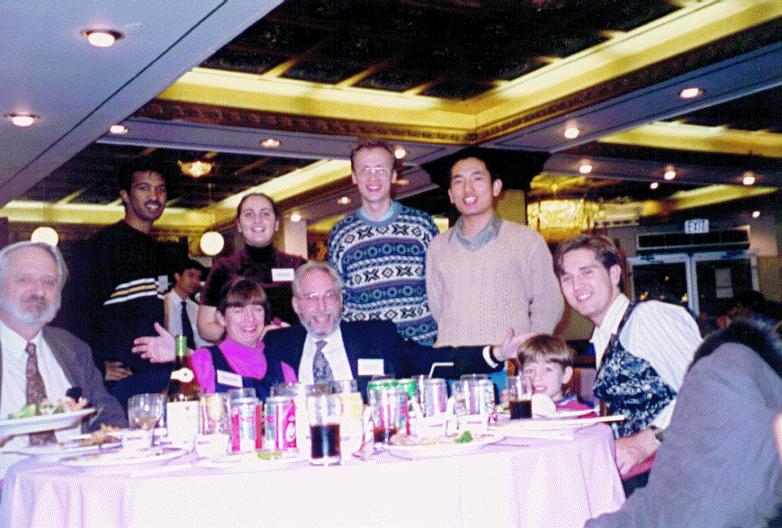
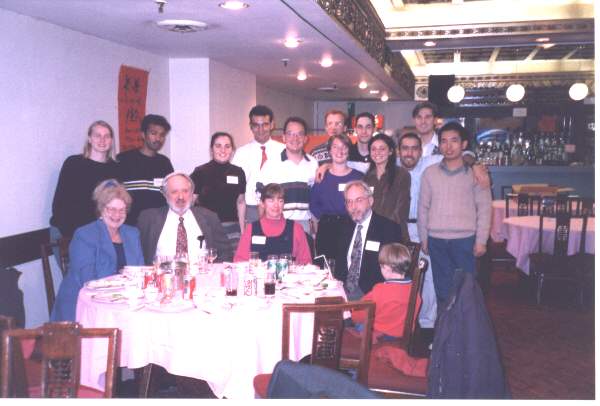
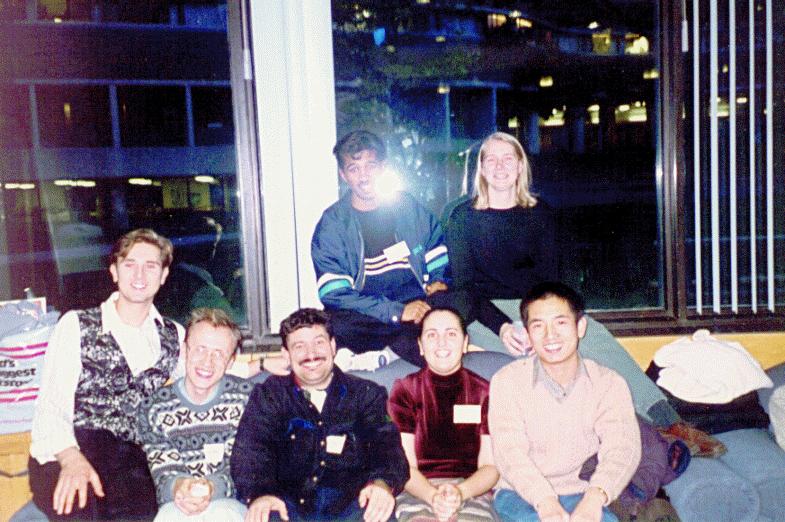
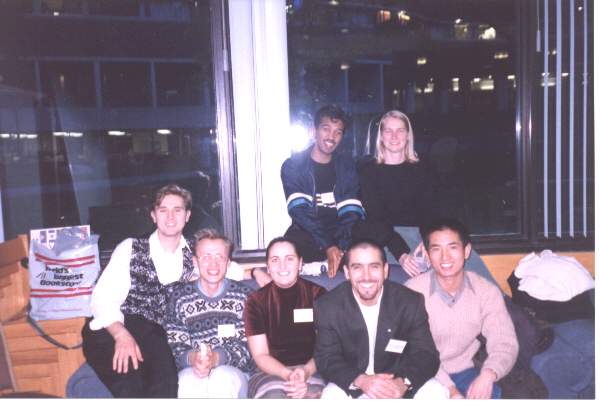
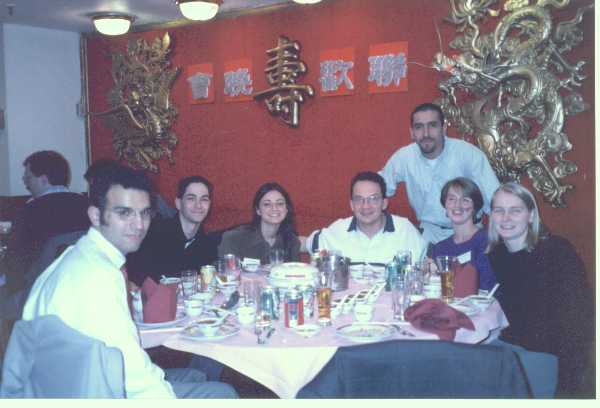
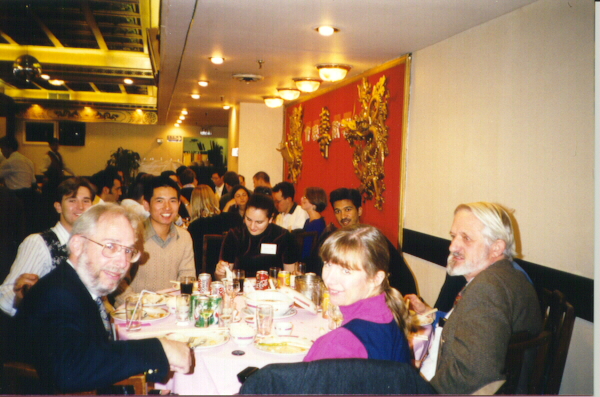
ACKNOWLEDGEMENTS
The committee would like to express its gratitude to the following sponsors for their generous financial support:
Department of Chemistry, University of Toronto
3M Canada
Innovative Technology
Perkin-Elmer (Canada) Limited
University of Toronto Chemistry Club
Waters
Digital Specialty Chemicals Limited
Nova Research and Technology Corporation
Xerox Research Centre of Canada
University of Toronto, Research and International Relations
Division of Inorganic Chemistry, Canadian Society of Chemistry
We are also grateful to the assistance of the following people:
Derek Gates - Web page
Mark MacLachlan - Program and booklet
Armando Marquez - registration and nametags
Tim Peckham - Program and booklet
Rui Resendes - Computer assistance